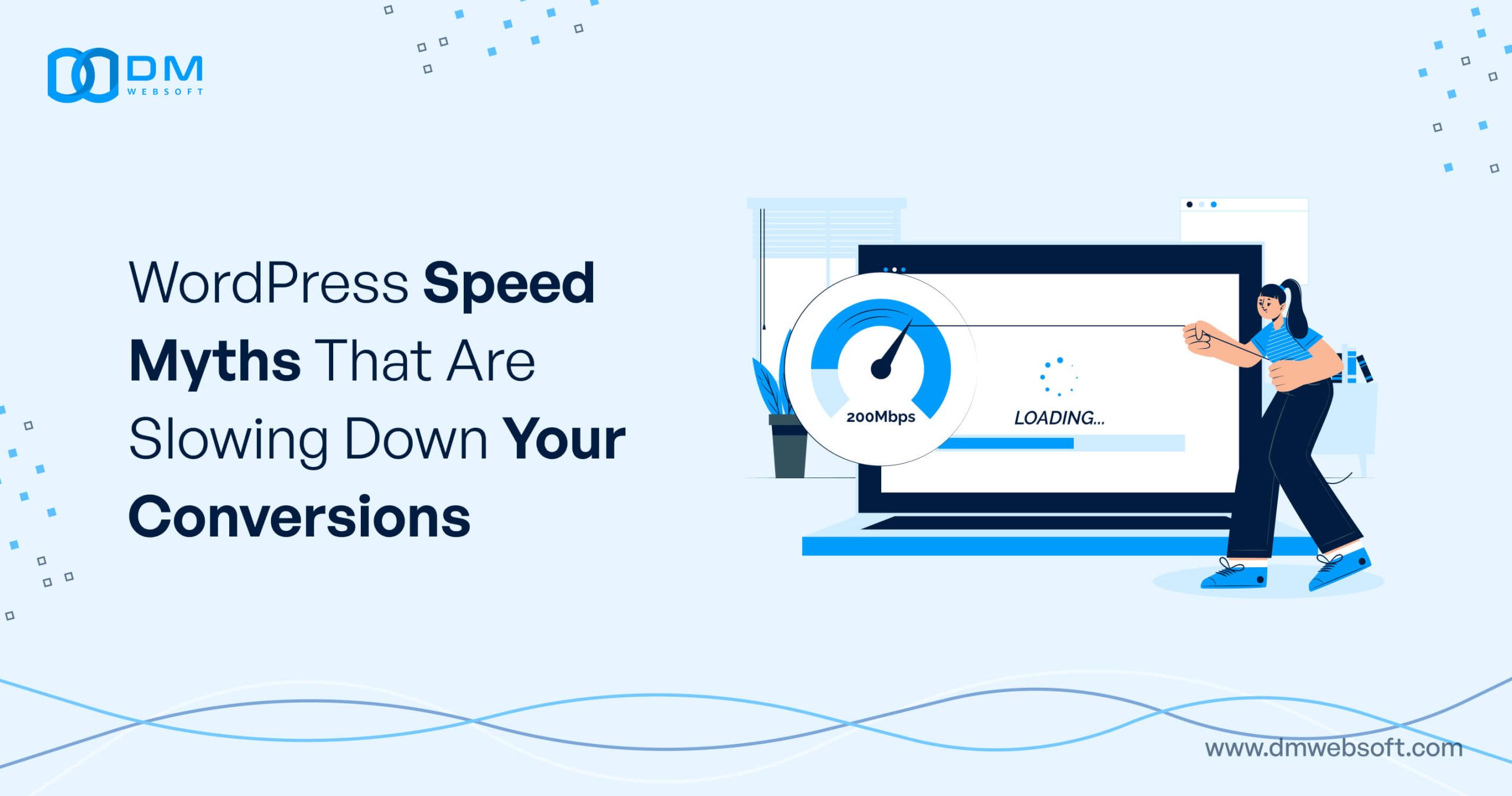DM WebSoft LLP exceeded our expectations! Their seasoned team of experts delivered a website that perfectly captures our brand essence. Their 15+ years of experience truly shine through in their exceptional web development skills.

TABLE OF CONTENT
Introduction
The Evolution of Medical Imaging
AI Technologies in Medical Imaging
Benefits of Integrating AI with Medical Imaging
Challenges and Ethical Considerations
Case Studies: AI-driven Breakthroughs in Medical Imaging
The Future of AI in Medical Imaging
DM WebSoft LLP’s Contributions to AI in Medical Imaging
Conclusion
Get in Touch
Introduction
The use of Artificial Intelligence (AI) in medical imaging means a changing step in the way of health diagnostics to a new era of precision and efficiency. Beyond automation, this technological evolution penetrates into the most basic processes of analysis and interpretation of complex medical images. AI in Medical Imaging is delivered with state-of-the-art algorithms and deep learning technologies that are designed to revolutionize conventional standards of care. In today’s environment, medical imaging with greater diagnostic accuracy, faster times for processing, and predictive insights like never before is bound to improve.
AI has its influence in medical imaging, ranging from routine screening procedures to the most complicated, disease-oriented diagnostics. More highly, through deep learning and convolutional neural networks (CNNs), AV systems are able to sift the patterns and anomalies from within the imaging data in ways that the best human observers’ eyes would not be able to perceive. These would facilitate early diagnosis of diseases, including cancer, neurological disorders, and cardiovascular conditions, hence greatly improve patient outcomes from facilitating timely and interventions that are well-targeted.
Furthermore, AI-driven tools are central to taking away pressure from the workload of radiologists and imaging specialists, which is becoming intense because of the increasing volume of images for review. Automating the first analysis of the scans with AI will enable the health professionals to derive expert work when the need is for a deeper investigation, thereby enhancing the diagnostic workflow and, in turn, patient care all over.
In this changing landscape contour, DM WebSoft LLP is emerging as visionary leadership integrating AI technologies into Medical Imaging. Ahead of its time, DM WebSoft LLP designs and deploys AI-driven solutions that cater to the fine needs of healthcare providers. Their breakthrough projects showed other companies not only an example of how AI could be of practical use in raising the level of accuracy and efficiency of diagnostics but also pointed at the seriousness of moving healthcare technology forward. DM WebSoft LLP wants to make a humble contribution to that future when medical diagnostics would be more accurate, accessible, and individual-based through unleashing the power of AI.
As AI progresses further and integrates with other technologies within the field of medical imaging, companies like DM WebSoft LLP will have their substantial inputs around. Their visionary approach will actually catapult the adoption of these AI technologies and assure that the health industry is at the leading innovation front, finally allowing better health outcomes and the whole transformed landscape of medical diagnostics.
The Evolution of Medical Imaging
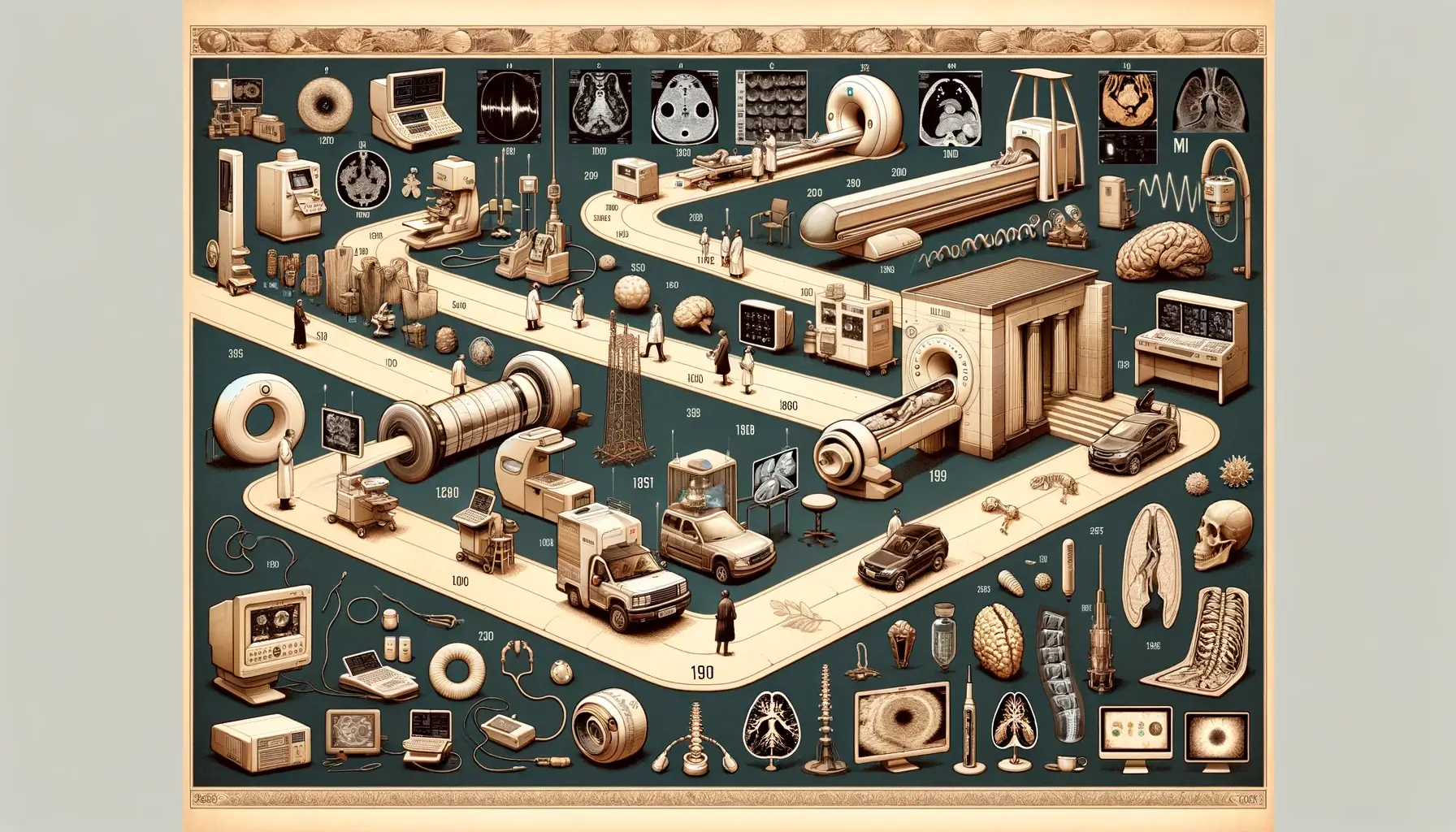
The tale of medical imaging from its birth to the modern day is an incredibly compelling story of how one technology has morphed, changed, and then innovated. In such a manner, this development has done much to increase the ability of healthcare providers to both diagnose and treat diseases while forever changing the manner in which medicine was conducted and increasing the level of patient care.
Brief History and Advancements in Medical Imaging Technologies
Medical imaging finds its roots in 1895, when Wilhelm Conrad Roentgen discovered X-rays, enabling, for the first time, the ability of doctors to look inside the human body without surgical intervention. This set the basis for the development of radiography and, in the future, other advanced devices of imaging. Over the past century, ultrasound has arisen as a safe, non-invasive means exercised for checking pregnancies and diagnosing various conditions.
The appearance of computed tomography (CT) in the 1970s, later on, literally revolutionized the identification and management of many diseases through its detailed cross-sectional images of the body. In the 1980s, Magnetic Resonance Imaging (MRI), which provided clearer information with the image contrast of soft tissues better than CT, was invented, not involving ionizing radiation.
Such advancements, together with the introduction of positron emission tomography (PET) and single-photon emission computed tomography (SPECT), extend diagnostic imaging towards more precise localization and characterization of abnormalities within the body.
Introduction to AI and Its Initial Applications in Healthcare
Artificial Intelligence (AI) was, therefore, built into the health system as the most recent addition to its evolutionary process. Its first application was in data management and predictive analytics, whereby it helped predict the occurrence of diseases and also put the records of the patient in order. However, it wasn’t long before the potential of AI in enhancing medical imaging became apparent.
AI-based algorithms, more so machine learning and deep learning-based, have shown excellent capabilities for analysis in imaging data. These technologies can identify patterns and anomalies within images at a speed and accuracy beyond human capability. Early applications included AI being used in the automatic detection of diabetic retinopathy from retinal images and helping in the diagnostic process by automatically locating possible tumors from mammograms, thereby proving that AI has got the capability to assist and make the diagnostic process better.
As AI technologies continue to mature, the applications being suggested and demonstrated in medical imaging are now going from improved diagnostic accuracy to personalized planning of treatment and predictive insights into patient outcomes. The evolution in the world of medical imaging, powered by sophisticated technology and AI integration, speaks volumes of relentless innovation for future healthcare in ever more precise and efficient diagnostics customized to the individual need of the patient.
AI Technologies in Medical Imaging
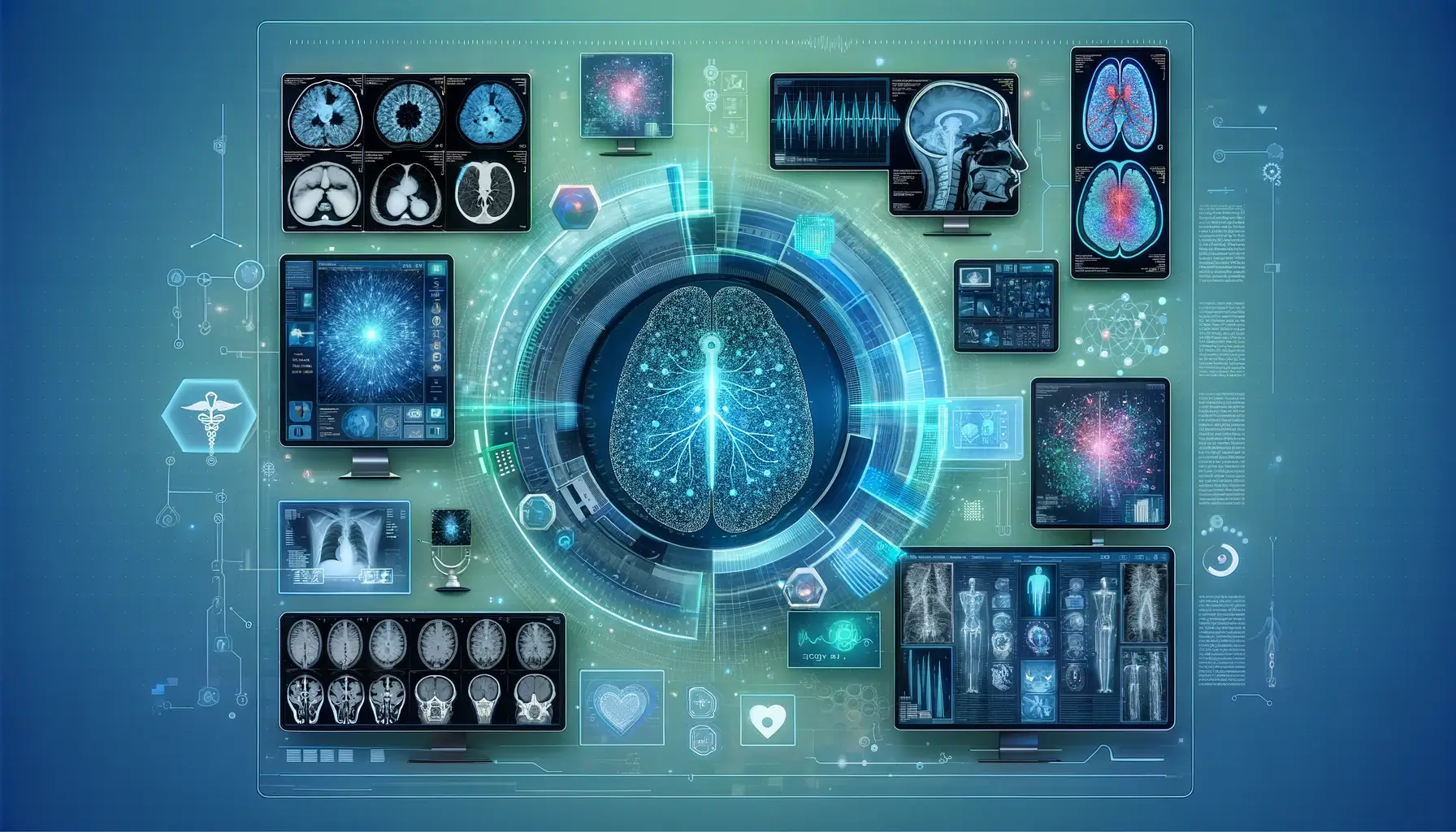
In particular, the endless potential of artificial intelligence (AI), through innovations like deep learning and CNNs, offers breakthrough techniques in the analysis and interpretation of medical images. The use of AI technologies in healthcare is not only empowering the medical professionals but is also making the diagnostic processes accurate and efficient.
Deep Learning and Convolutional Neural Networks (CNNs)
Deep learning is also a part of machine learning and acts based on the mechanism that human brains implement, thereby allowing the system to learn from abundant amounts of data. Convolutional neural networks (CNNs) are most effective with pixel data from images and find large application in medical imaging. CNNs were very effective in image analysis tasks, such as identifying diseases from X-rays, MRIs, or CT scans, since they could automatically and adaptively learn spatial hierarchies of features from input images.
For example, CNNs have found wide application in the detection of different types of abnormalities with high precision, like those of tumors, fractures, or zones of inflammation, and in some cases, even before such abnormalities have become visible to the human naked eye.
Image Segmentation and Reconstruction
AI technologies show huge improvement in the process of image segmentation and reconstruction, which are the steps of paramount importance in medical imaging. This involves breaking up a digital image into large numbers of segments or pixels in order to aid analysis or improve quality.
Segmentation is useful for the isolation of regions of interest in an image for detailed study, while reconstruction techniques help in creating 3D models from 2D images, which are helpful for giving insights into anatomical structures. This is where AI can enable these processes, being much faster and far more accurate than the human eye, to lead to much more effective diagnosis and strategic planning of treatments for patients by clinicians.
Predictive Analytics and Radiomics
Predictive analytics in medical imaging involve analysis based on imaging data, both historical and in real-time, in such a way that it can allow for predictions about trends, outcomes, or just an indication of the possibility of diseases. AI-driven predictive analytics could be impactful on patient care due to predictive disease development and treatment response, which might prove to be helpful in implementing personalized medicine. Yet another place where AI is being applied is in radiomics, which refers to the data-characterization algorithms of quantitative features from medical images. By translating images into high-dimensional data, AI pries open these hitherto sealed details of characteristics of diseases not visible to humans and may add to the fuller understanding of a patient’s condition and treatment pathways.
Essentially, the integrations of AI technologies, including deep learning, CNNs, image segmentation, and predictive analytics into medical imaging, present a sea change from the current diagnostics paradigm. Therefore, these developments enhance, not only the capability of radiologists for accurate detection and diagnosis of diseases, but also bring new hope for improved patient outcomes through more informed planning and management of treatments. It is without a doubt that there is room for the wider role of AI in medical imaging in the future, since AI will keep advancing in its development.
Benefits of Integrating AI with Medical Imaging
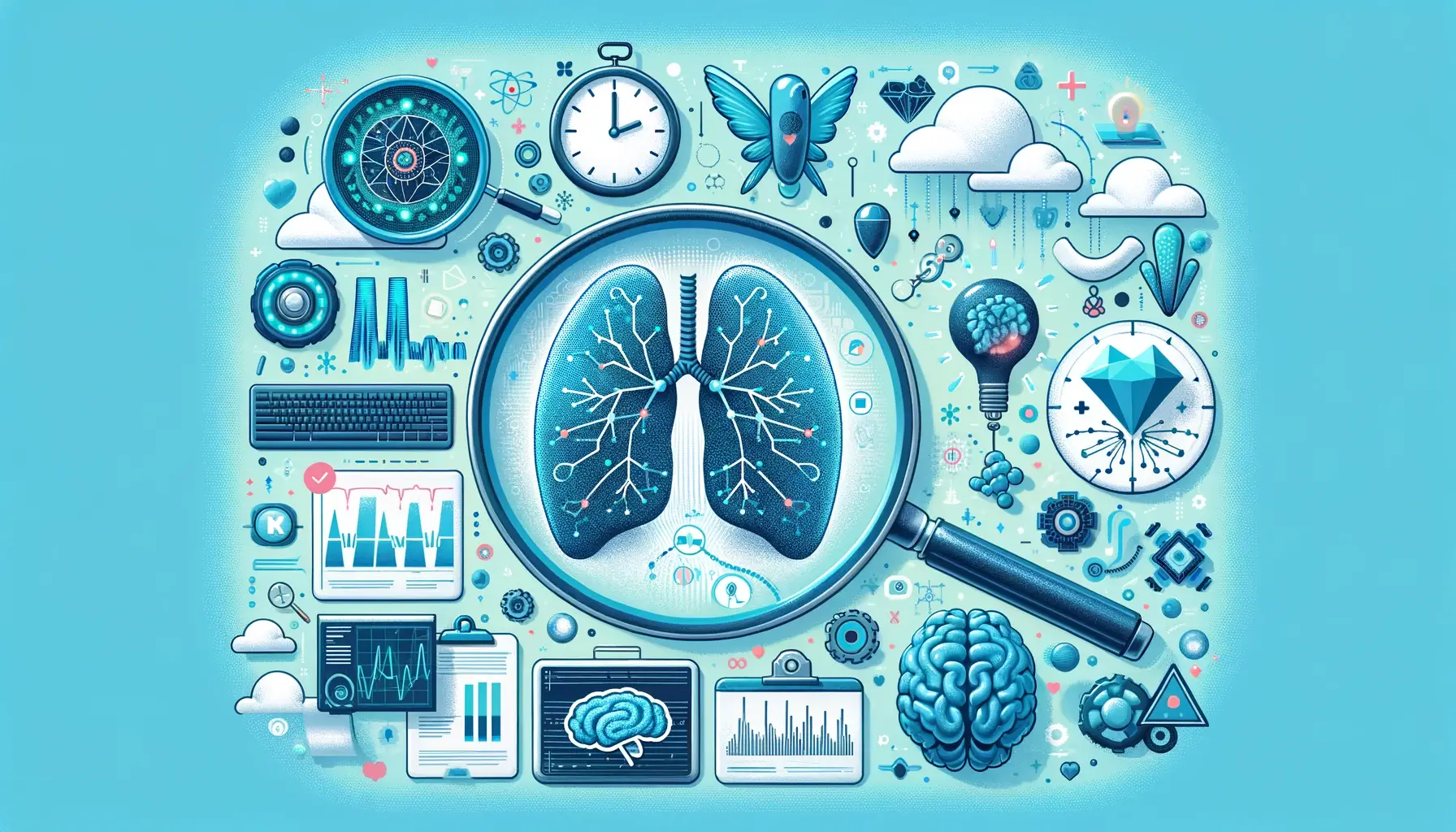
Including Artificial Intelligence (AI) in medical imaging will redefine diagnosis and patient care. Engaging AI in medical imaging gives healthcare professionals better precision, efficiency, and focus on the patient. Now, let us go a bit deeper to understand these key benefits of the fusion of AI with medical imaging.
Enhanced Accuracy and Diagnostic Precision
However, complex medical images may contain more details, and at times, a better way of image processing than the human mind consists of advanced artificial intelligence algorithms of deep learning. And so, all of these faint patterns and anomalies in images, including those of tumors, fractures, or signs of diseases like pneumonia, often at a stage earlier than it is humanly possible, are things the algorithm can spot. This increases the accuracy in diagnosing the early detection of conditions, which makes it possible for quick intervention with a high success rate in treatment.
Increased Efficiency and Reduced Workload for Radiologists One of the most immediate paybacks of AI in medical imaging includes increased efficiency in the processing and analysis of imaging studies. AI systems could offer the image studies’ quick review and possibly even prioritize them on the grounds of detecting the critical findings. This way, radiologists will focus their expertise exactly where it will be most needed. This will not only be able to fast-track the diagnostic process but also suppress the fast-growing workload of radiologists, who are often highly exposed to imaging studies in high volumes.
AI streamlines the daily scheduling of the radiologists so that they get more time for the tricky cases and counseling for the patients, hence quality is improved.
Improved Patient Outcomes and Personalized Treatment Plans The precision and efficiency brought about by AI contribute directly to better patient outcomes. For example, in the case of diagnosis, earlier and more accurate diagnostics inform much more effective treatment, probably reducing the number of times invasive procedures are needed that take their toll on the body and result in long recovery periods.
Moreover, AI has the potential to look into imaging data vis-à-vis the medical history of a patient and certainly help devise personalized treatment planning. The artificial intelligence could be used to guide clinicians in offering the best interventions on a case-to-case scenario where the previous cases had the same or similar outcomes. In summary, such infusion of AI with medical imaging makes a prominent stride in medical technology.
From increased levels of diagnostic accuracy and efficiency to greater numbers of patient outcomes, this paves the way for medical diagnostics to be revolutionized by AI and, indeed, even treatment planning. These AI technologies and deployments within healthcare practice improve. Greater impacts are expected in the future on medical imaging and its effect on patient care, thus corresponding to a new future in precision medicine.
Challenges and Ethical Considerations
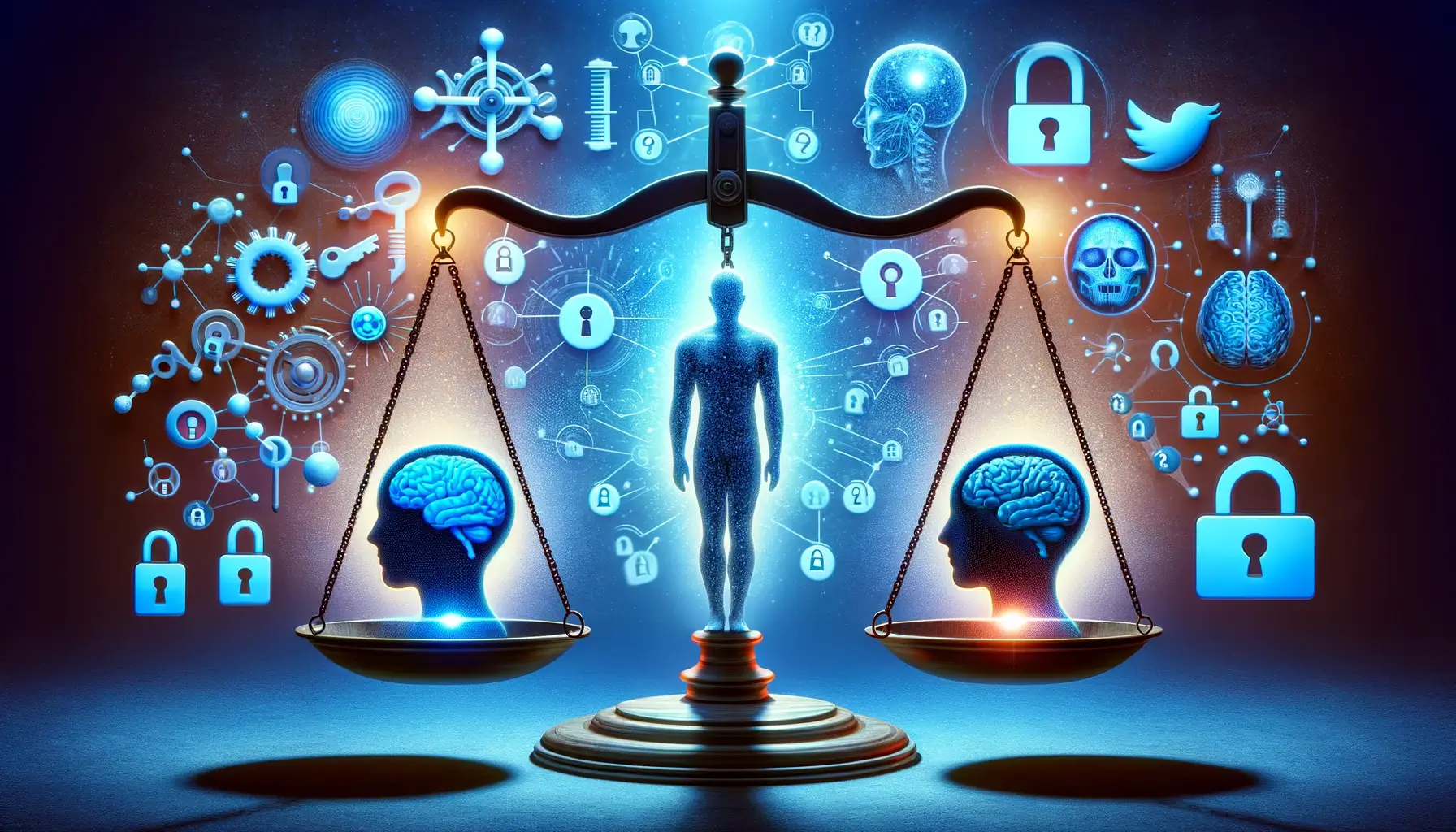
Even though the usage of Artificial Intelligence (AI) is revolutionary within the realm of medical imaging, it brings a spectrum of challenges and ethical considerations that should be closely threaded. All these issues hover from ensuring the privacy and security of the patients’ data to the elimination of possible biases within the AI algorithms and integration of these technologies within the existing paradigms of healthcare.
Data Privacy and Security in Medical Imaging
The major preoccupation during the implementation of AI in medical imaging remains the protection of patients’ data privacy and security. Being part of sensitive health information, medical images form part of the strictly regulated acts, including the Health Insurance Portability and Accountability Act (HIPAA) in the United States. AI systems having such images in their possession, therefore, had to have set up strong impenetrable security walls, not to avoid any possible breaches.
The training data to build models need to be used at the same time as ensuring the patients’ data are anonymized and indeed balanced against the preservation of clinically relevant information.
Bias and Variability in AI Algorithms
The second major challenge is the risk of bias and variation within AI algorithms. The AI system is usually trained on a large dataset of medical images. In case this dataset is non-representative for the varied patient population, then the model will be suffering from biases.
For instance, an AI model trained mostly on images from one demographic group does badly while analyzing images from another demographic group. This may lead to misdiagnosis or, worse, failure in the diagnosis of conditions, which may compromise the sought level of accuracy and fairness in the analysis of medical images. So, all these biases shall be addressed by curating training datasets with diversity and inclusiveness. The model will be evaluated for a multiplicity of populations.
Integration with Existing Healthcare Systems
The big, however, lies in the integration of such AI-powered medical imaging technologies into the system. Most of the healthcare providers would be having legacy systems that may not be adapting very easily to the latest solutions by AI. Not only the upgrading of AI systems but also the coordination of enormous investment and training of medical staff to make them use these new tools effectively. Besides, the integration will ensure that the enhanced imaging services by AI will be able to mesh well with the flow of traditional diagnoses, enhancing rather than interrupting clinical works.
Solutions to these challenges and the ethical consideration of their solutions constitute the fulcrum of the full potential of AI in medical imaging. Efforts toward improving data privacy and security, dealing with algorithmic bias, and smoothly integrating AI technologies in healthcare systems are really challenging and very important if we are to improve practice in medical imaging. With those addressed, AI in medical diagnosis has potential salient impacts on efficiency, accuracy, and patient outcomes that have previously not been recorded through prior centuries of healthcare innovation.
Case Studies: AI-driven Breakthroughs in Medical Imaging
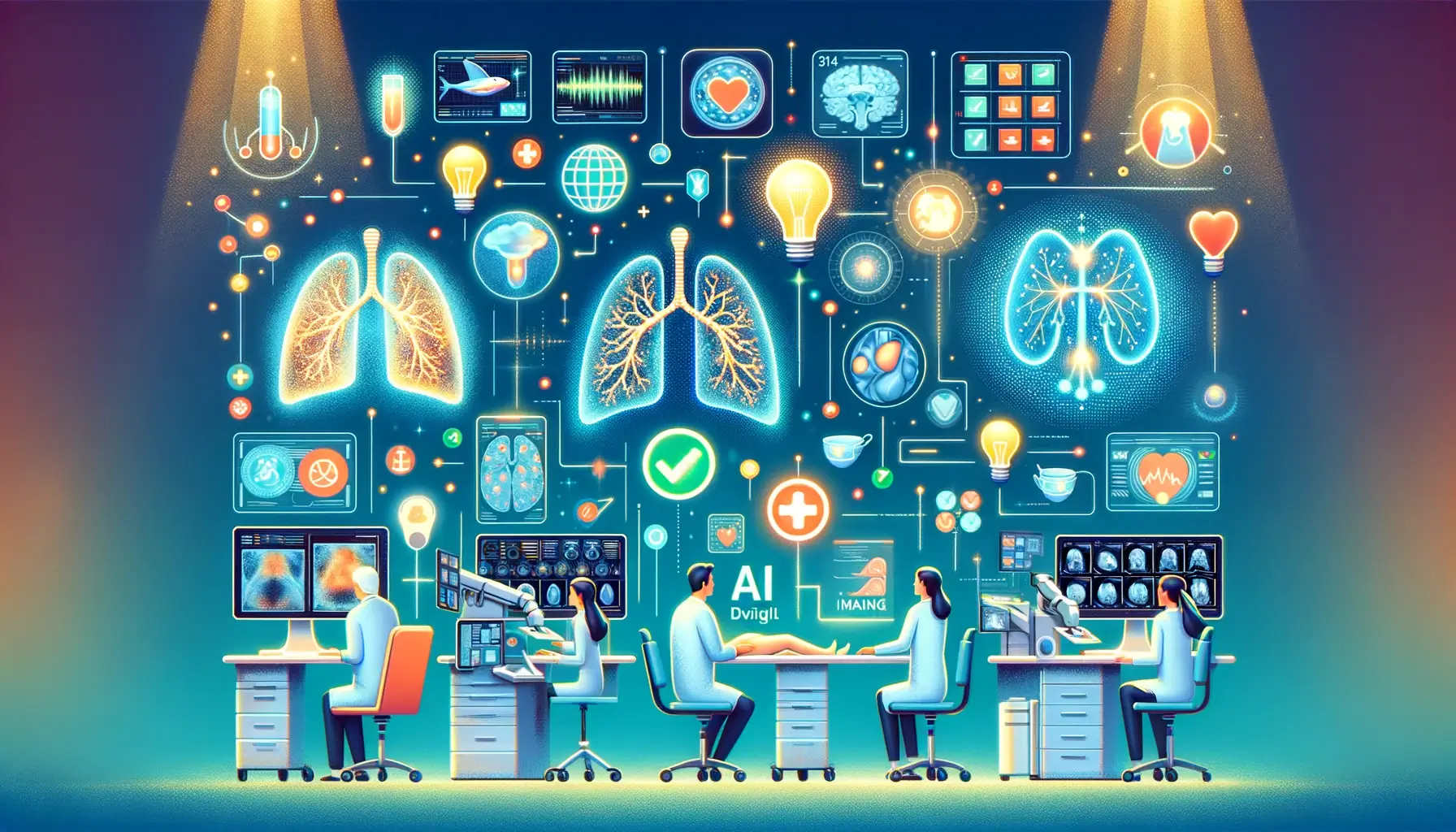
The amalgamation of Artificial Intelligence (AI) technologies in medical imaging is yielding great performance in disease diagnosis, and hence proving the promise of transforming health care. A list of such impactful strides made by AI applications in the arena of medical diagnostics is enlisted through real-world examples mentioned below:
Detection of Diabetic Retinopathy One of the striking successes of AI in medical imaging is for it to be applied in early detection in diabetic retinopathy, which can ultimately lead to blindness if untreated. It is developed by Google’s DeepMind, an artificial intelligence system that can, in fact, carry out accurate analysis of retinal images just like human experts. This helps in screening the patients much in advance and allows adequate intervening time for the clinician, which ultimately can yield great reduction in the risk of severe vision loss.
The very fast processing system and evaluation of thousands of images it presents easily transcend the limits of manual diagnosis and thereby illustrate AI’s potential ability to enhance not only efficiency but also the coverage of the health service.
Early Diagnosis of Alzheimer’s Disease
Further, AI algorithms are improving to help in the early recognition of symptoms that will develop into Alzheimer’s, long before these can become obvious to doctors. Using AI, the PET analysis algorithm has features of the amyloid-beta plaques, which is a signature of Alzheimer’s disease, identified much more precisely and may appear years before they become visible with conventional ways of diagnosis. Early detection of this serious condition opens a window for disease management with interventions that can be implemented at a point early enough to arrest its progression, ultimately resulting in significant quality of life improvement for patients.
Breast Cancer Detection The approach improved a minimum of 11.5% with the use of AI in the analysis of mammograms. An AI system developed and trained by researchers in tandem with radiologists actually performed better at picking out breast cancer from mammograms than either of the two expert groups. The system thus reduces many false-positive as well as false-negative results, but in such a way that more women will be properly diagnosed. Early detection through this AI screening holds out the opportunity for more effective treatment and better results for many women.
Automated Analysis of Chest X-Rays The COVID-19 pandemic has very well exhibited the need for rapid diagnostics during health crises. Chest X-ray tools that can use AI quickly to diagnose whether there is COVID-19 infection in an individual.
Such tools played their indispensable roles in patient triage, healthcare workforce management during the peaks of any pandemic, hence are pivotal to AI in emergency response and public health. These case studies highlight AI’s transformative impact on medical imaging and disease diagnosis. From debilitating neurological and psychiatric diseases to cases like cancer, heart diseases, and diabetes, which create significant premature disability and mortality, AI-powered technologies also provide for more efficient, personable treatment plans that ultimately foster positive patient outcomes against a number of conditions. Applied in medical imaging, AI is an exciting frontier of continued development and application that promises to alter diagnostics exponentially and further patient care.
The Future of AI in Medical Imaging
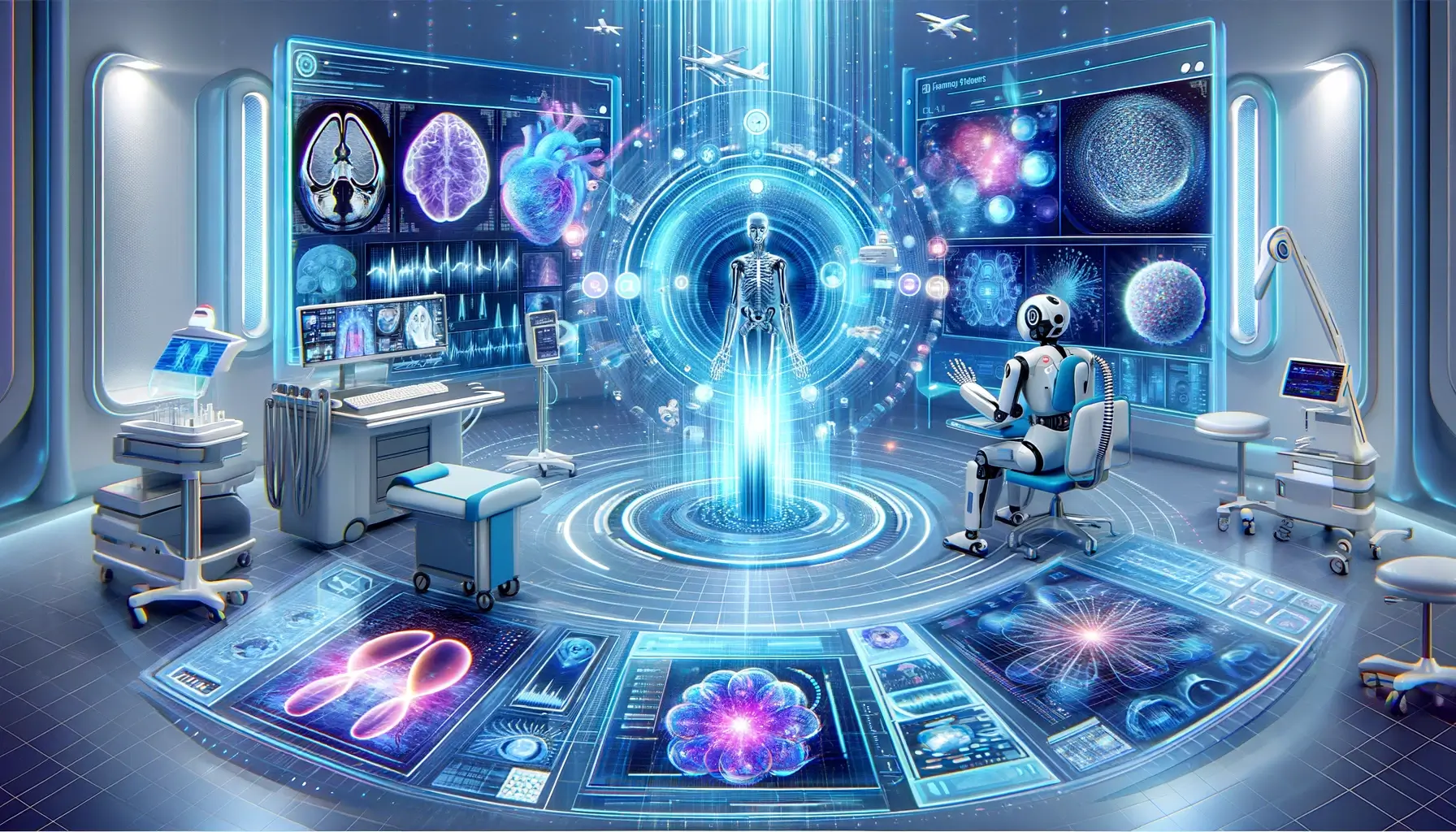
With such emerging trends and technologies, therefore, the stage seems set for the explosion of AI- Artificial Intelligence (AI) powered Medical Imaging in the near future, having the potential for providing an alternative window for redefining diagnostics in the healthcare space. Now, with AI evolving at such rapid progress, the integration of machine learning and medical imaging is set to grow stronger every day and open up a new chapter for precision, efficiency, and personal care for the patient.
Emerging Trends and Technologies in AI for Healthcare Federated Learning for AI Models
Another developing trend for AI development, federated learning in healthcare is a method in which an algorithm is trained across various decentralized devices or servers while holding their respective local data samples.
This respects privacy and security of data belonging to patients since the sharing of individual patient data does not occur. In medical imaging, federated learning contributes toward improving diagnostic accuracy for AI models without breaching the confidentiality of data by distributing the same across the globe.
- Augmented Reality (AR) and Virtual Reality (VR): Represents new ways in the field of medical imaging, through the immersive visualization of imaging data. In these cases, AR superimposes medical images on the body of the patient directly in the course of the procedures, hence adding precision to ways of performing surgical operations. This information may be further processed using VR combined with AI, which could be used for the creation of a very detailed 3D model that would allow a doctor to view the anatomical structure in-depth, therefore improving not only the diagnosis but also helping in the treatment plan.
- Quantum Computing: Quantum computing is still in its infancy, but it has the potential to break through in the fields of AI and medical imaging. Quantum computers can process data thousands of times faster in huge volumes of information than classical computers. Real-time diagnostics through AI may be possible from quantum computers, as they will process such huge information in significantly reduced time, which is going to bring a revolution in emergency medicine and critical care.
Predictions for AI’s Evolving Role in Medical Diagnostics Personalized Treatment Plans
An evolving role of AI in medical imaging is the personalization of the treatment plan. Imaging data, analyzed together with the genetic information and history of the patient, can predict responses to different treatment regimens, therefore helping select one that most suits the patient.
- Preventive Medicine: AI will likely play a pivotal role in shifting the focus from reactive to preventive medicine. With leading predictive analytics, the risk factors, and early symptoms of disease from medical images can be detected; therefore, in the absence of clinical symptoms, it is possible to take all preventive actions, hence decreased costs for health care with favorable patient outcomes.
- World accessible expert diagnostics: AI in medical imaging tools provides the opportunity for world applications, even in remote and underdeveloped regions, meaning world accessible expert diagnostics. Any such democratization of health services has the potential to bring the differences in level down.
It’s an area with really huge potential because the technological advances are really pushing the boundaries, both in diagnostics and patient care. The role of AI can only expand with maturity in these technologies and deeper penetration in healthcare systems. Full integration of AI into this field would revolutionize medical imaging, or perhaps even more.
DM WebSoft LLP’s Contributions to AI in Medical Imaging
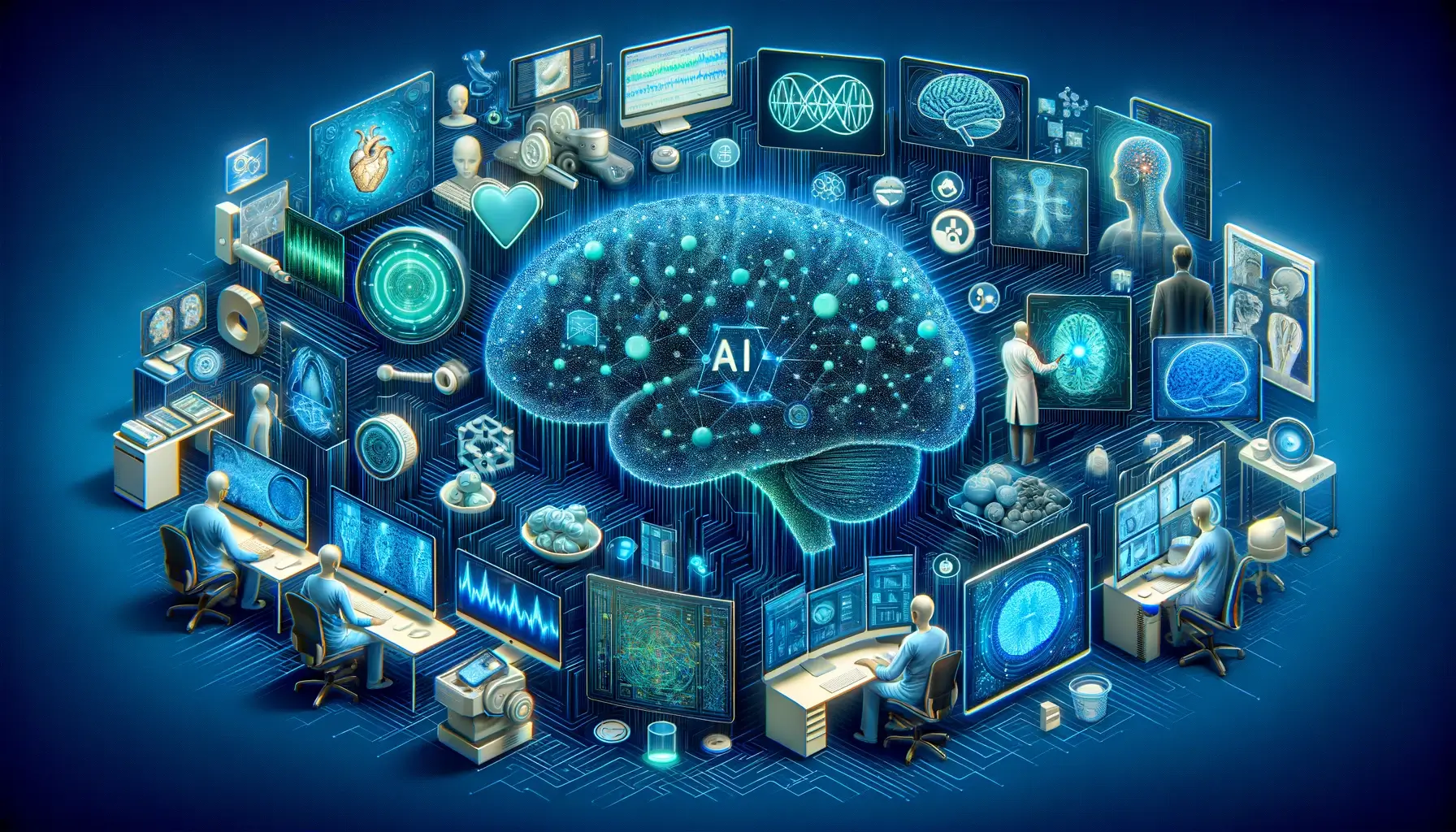
DM WebSoft LLP is the leader in embedded Artificial Intelligence (AI) technologies for medical imaging, with a great commitment to the use of these technologies that will assist in making advancements toward improved diagnostic accuracies, better patient outcomes, and the process of health care efficiency. Through innovative projects and solutions, DM WebSoft LLP is turning into a part of the AI revolution in health and actively forming the path.
Overview of DM WebSoft LLP’s AI Projects and Solutions in Healthcare DM WebSoft LLP has developed a suite of AI-powered tools and platforms aimed at transforming medical imaging. The company is also involved in these projects, such as deep learning to model highly precise analysis for medical images. One such project involves a flagship AI system that is able to spot early signs of diseases like cancer in imaging scans long before they might be picked up through conventional methods.
Another breakthrough solution of DM WebSoft LLP is the automated image segmentation platform that reduces the radiologist’s time on image analysis to a bigger proportion and enables focus on diagnosis, patient care, and other related tasks.
How DM WebSoft LLP is Overcoming Industry Challenges with AI The major challenge in the field of medical imaging still was an issue of managing the huge amount of data generated on a day-to-day basis. DM WebSoft LLP makes sure this is handled through the introduction of AI algorithms to process and analyze imaging data faster, hence reducing the bottleneck of data analysis and, in turn, speed up diagnostics.
Being aware of any possible bias in the AI models and hence focusing on a wider training dataset, DM WebSoft LLP ensures that its AI systems are the most accurate and fair. The company is also strongly committed to user-oriented interfaces in its AI solutions; that is, even a healthcare specialist with modest technical skills should be able to take advantage of the best that advanced technology offers.
Vision for the Future of Medical Imaging with AI Technologies
Further forward, DM WebSoft LLP sees a envisioning future where AI does not replace a human medical professional in imaging diagnostics but supports and greatly boosts his potential. The company has been looking forward to AI technologies bringing more accurate and personalized diagnostics.
For instance, artificial intelligence might predict patient outcomes from imaging data and other health indicators, using revolutionary approaches that will pave way for even more personalized treatment plans. DM WebSoft LLP is also leveraging deep synergies presented by integrating AI with other technologies in areas such as augmented reality in surgical planning and virtual reality in educational training to enrich utility in the field of medical imaging.
DM WebSoft LLP cites an example of AI in Medical Imaging in which they suggest their contribution as a representation of good knowledge and understanding of the huge potential of AI technology to revolutionize healthcare. In the process, DM WebSoft LLP is greatly overhauling the current diagnostic process by not only creating innovative AI solutions for them but also taming a new wave in medical imaging that might be more accurate, efficient, and integral to patient care than ever before.
Conclusion
One of the disruptive changes in the medical industry is the introduction of Artificial Intelligence (AI) technologies in medical imaging because it is one of the opportunities unpaired with improved diagnostic precision, operation optimization, and improvement of patient care. Our journey in this blog covered the landscape of AI’s revolutionary impact on medical imaging: from foundational technologies and applications to where real value is derived, and from its tangible benefits to challenges. Real-world examples and case studies, however, have gone on to prove that indeed artificial intelligence can diagnose diseases with accuracy and speed never before realized, thereby changing the outlook for innumerable patients across the world.
From innovating new digital waves and techniques, DM WebSoft LLP has been an emerging player in these transforming times that actually makes it showcase their visionary approach and bring innovative solutions that have the deepest potential when meeting technology with healthcare. This article also collates the contributions from these authors to add strength to the importance of constant innovation and adoption required to harness the complete potential of AI in medical imaging. As they forge their way among industry challenges with cutting edge AI projects, DM WebSoft LLP will have tackled not only current needs but will lay the groundwork for future evolvements that promise only to further revolutionize medical diagnostics.
Down the road, the trajectory of AI in medical imaging is exponential growth driven by emerging trends and technologies which, again, promise to deepen its impact. The future imagines an imagination in which not just the tools available for radiologists but, in fact, the very substrate of patient care itself is AI-powered diagnostics that provide insight into treatment plans and ways to improve outcomes. Undoubtedly expand as AI technologies mature into medical imaging.
Such integration for medical imaging will doubtlessly become more common as AI matures into practicality for a variety of medical uses.
In conclusion, the journey of AI in medical imaging is just beginning. With companies like DM WebSoft LLP leading from the front, it is the healthcare industry at the helm of a new horizon, wherein the power of AI is revolutionizing medical diagnostics. The promise of redefining medical imaging and diagnostics by AI is not just inspiring; it’s a sign of the unbelievable leaps in technology and healthcare. Moving forward, this assures there will be more innovations in the field and continued collaboration between the tech world, health professionals, and researchers. It is going to take a lot for the industry to really find their potential and, at long last, light up the future with diagnostic excellence and patient care.
It helps in improving the accuracy of diagnosis through the provision of systems for analyzing medical imaging based on complex algorithms, among others. It may be capable of noticing very subtle patterns or even anomalies that human vision would not, allowing for earlier and more accurate diagnosis of diseases like cancer, neurological disorders, or heart disease.
Indeed, the workload of a radiologist could be much reduced when routine analysis tasks are carried out fully automatically, without any human intervention. This allows radiologists to focus on more complex cases and interpretive work, enhancing efficiency in workflow while reducing the potential for diagnostic errors from radiologist fatigue or high case volume.
This includes sensitive data privacy and security, bias and variance in the AI algorithms, which may result in incorrect diagnosis, and integration of the systems with the existing structures and workflows of clinical practice.
DM WebSoft LLP is at the forefront of developing AI-based solutions for medical imaging. These solutions provide an increase in diagnostic accuracy while streamlining operations, from patient journey to reporting. The company is aimed to develop breakthrough algorithms for image analysis and predictive diagnostics that will help in overcoming the current standing challenges in the industry and will surely define the future for healthcare diagnostics.
Any further development or augmentation in the domain of AI-enabled medical imaging would unleash much more advanced predictive analytic algorithms, AR/VR integration for better visualization and surgical pre-planning through the medical images, and federated learning models to increase the AI training mechanisms without allowing the privacy of patient data. That means we can expect further tailor-made diagnostic and treatment plans really based on AI-driven insights, so that healthcare is really tailor-made for each individual patient.
Get Started Now !
What’s the Process ?
Request a Call
Consultation Meeting
Crafting a Tailored Proposal
Get Started Now !
Real Stories, Real Results. Discover What Our Clients Say

Working with DM WebSoft LLP was a game-changer for our business. Their technical prowess and innovative solutions transformed our online presence. A highly recommended web development agency with a stellar track record.

We are thrilled with the results DM WebSoft LLP delivered. Their deep understanding of web development coupled with years of expertise ensured a seamless and visually stunning website. True professionals!

In a digital age where first impressions matter, DM WebSoft LLP crafted a website that speaks volumes. The team’s attention to detail and commitment to quality set them apart. Thank you for making our vision a reality.

DM WebSoft LLP’s team demonstrated unparalleled expertise. Their ability to navigate complex technical challenges with ease is truly commendable. Choosing them for our web development needs was the best decision.

Exceptional service, unmatched skills! DM WebSoft LLP stands out as a leading web development agency. Their collaborative approach and commitment to excellence make them our go-to partner for all things web-related.

DM WebSoft LLP turned our ideas into a digital masterpiece. The seamless communication and timely delivery of our project showcased their professionalism. Highly impressed with the level of creativity and skill.

Our experience with DM WebSoft LLP was nothing short of amazing. From concept to execution, their team provided top-notch web development services. A reliable partner for businesses looking to elevate their online presence.

DM WebSoft LLP’s team of tech experts is second to none. Their wealth of experience reflects in the quality of their work. Our website not only meets but exceeds industry standards, thanks to their dedication.

Choosing DM WebSoft LLP was the best investment for our web development needs. Their team’s proficiency, coupled with a customer-centric approach, made the entire process smooth and enjoyable. A pleasure to work with!





